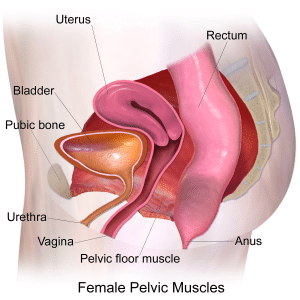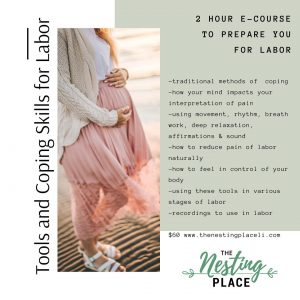
Jul 2, 2020 | Birth
Pelvic What?
 The pelvic floor is the layer of muscles that stretch under the pelvis and support the inner organs (bowels, uterus, and bladder). I had never heard of the pelvic floor until I started learning about pregnancy and birth. Even though I was already suffering from and getting treated for a pelvic floor dysfunction long before I became pregnant, no one, not my OB or physical therapist, explained what the pelvic floor muscles did and how they could impact my well-being.
The pelvic floor is the layer of muscles that stretch under the pelvis and support the inner organs (bowels, uterus, and bladder). I had never heard of the pelvic floor until I started learning about pregnancy and birth. Even though I was already suffering from and getting treated for a pelvic floor dysfunction long before I became pregnant, no one, not my OB or physical therapist, explained what the pelvic floor muscles did and how they could impact my well-being.
Turns out, as I would later learn, my pelvic floor could wreak a lot of havoc on my body during pregnancy and labor. My pelvic instability lead to symphysis pubis disorder that caused excruciating pelvic girdle pain that still lingers today, one year after I gave birth. The pulling on my pelvic muscles also lead to a lot of back pain.
To learn more about pelvic health, I reached out to Rachel Parrotta, DPT, a pelvic health physical therapist.
During Birth
“I believe that all people would benefit from learning about their pelvic floor muscles prior to giving birth,” Dr. Parrotta said. “Since we are often unfamiliar with these muscles, it can be difficult for people to use their pelvic floor muscles in ways that help facilitate both birthing and post-partum recovery.”
Imagine, you are in labor and your care provider says, “Okay, it’s time to push.” Many birthing people may feel that bearing down feeling, that urgent need and desire to push. However, receiving an epidural can prevent people from experiencing bearing down and even from pushing effectively because the abdominal and pelvic floor muscles feel numb. Care providers do something called “coached” or “directed pushing” until the laboring person gets the hang of how to push. Your care provider will tell you when and how to push in accordance with your contractions.
This happened to me. I got an epidural during back labor and didn’t have the bear down feeling until my water broke. My midwife coached my pushing because I wasn’t using my pelvic floor muscles correctly. She told me I wasn’t doing right. She got frustrated and impatient with me. She actually shoved her finger up my bum WITHOUT INFORMED CONSENT to pinpoint the muscles I should be using – an action that still makes me shudder and feel small to this day. I don’t want this to happen to you.
Pushing Practice
Ideally, we want our pelvic floor muscles to be relaxed during the second stage of labor (pushing), as tensing those muscles can actually delay birth. You can go to a professional like Dr. Parrotta to identify your pelvic floor muscles and learn how to use them for pushing BEFORE labor.
“Learning about your pelvic floor muscles prior to birth can help prepare for a more effective pushing phase of birth, especially if a person is planning on birthing with an obstetrician and/or with an epidural,” said Dr. Parrotta.
Pushing your baby into the world is a powerful action that we are all capable of doing. Exploring your pelvic floor to ensure its health and learn about its abilities can make an impact on your birth and postpartum experiences.

Apr 23, 2020 | Birth, Coping Skills
Coping During Natural Birth Pain. How Do I Do It?
Is coping through natural birth pain possible? This is the most frequent question I get from moms, whether they’re approaching their first or fifth birth. Labor pain appears to be the number one concern about birthing. Many believe an epidural is their only option. But I’m here to tell you, that there are more natural alternatives than you may think.
If having a natural, meaning no medical interventions, birth is important to you, then you’re going to want all the information you can get on coping with labor pain. And yes, I’m saying pain. Some educators don’t like to use the “p” word, mostly because as soon as we hear that word we tense up and think of it negatively. But I want to be realistic here. Yes, it is pain, but it’s not negative. It has a beautiful purpose and it is possible to naturally reduce labor pain through coping techniques.
Become The Ruler Of Your Mind
Staying relaxed and as calm as possible during natural birth contractions is very important. When we feel pain, our body’s stress response is called to action. We get a rush of adrenaline and cortisol, leading to a faster heart rate and increased breathing. This isn’t a bad thing. Our body is trying to help us prepare for fight or flight and the chemicals that flood our body actually helps reduce pain. I know, cool, right?
But the downside of the stress response is that it can quickly turn us to panic and fear if we don’t know how to control it. The trick to coping in labor is to become the ruler of your mind.
You’re already a queen. Now you need to be the queen of your thoughts by thinking positively and learning physical and mental skills to harness your power and focus.

How Do I Learn These Skills?
You can read as many free articles and resources about labor pain coping skills as possible. However, this will not compare to learning these methods from an actual childbirth educator. Reducing pain naturally during labor requires practice throughout pregnancy and you need someone who can go in depth about these techniques and give you alternatives that you can’t get elsewhere.
This is why I’ve partnered with The Nesting Place LI to offer a new online class that deals solely with natural birth coping skills and why all of my online birth education courses cover comfort measures and coping techniques.

Mar 13, 2020 | Birth, Postpartum
Tensions about COVID-19, a type of coronavirus, are rising in the United States as the illness has been spreading. Travel is becoming restricted, people are working from home, schools are closing, and apparently toilet paper is now a hot commodity. Many are starting to panic. The symptoms of COVID-19 have mainly proven to be more serious in older patients and those with serious complications such as heart and lung disease, and diabetes. But what about pregnant women and new moms?
Are Pregnant Women More Susceptible to Getting COVID-19 or at Higher Risk of Serious Illness?
At this time, the CDC does not have conclusive information. However, the physiological changes women experience during pregnancy do tend to make them more susceptible to viral respiratory infections. The CDC advises pregnant women to take standard precautions like washing their hands and avoiding other people who are sick.
Can COVID-19 be Transmitted to Babies During Pregnancy or Vaginal Birth?
The virus is currently thought to only be spread through respiratory droplets, meaning through fluids expelled by the mouth and nose during coughs, sneezes or intimate contact. It is unknown if the virus can be transmitted through the womb. However, the CDC said, “In limited recent case series of infants born to mothers with COVID-19 published in the peer-reviewed literature, none of the infants have tested positive for the virus that causes COVID-19. Additionally, virus was not detected in samples of amniotic fluid or breastmilk.”
Can I Continue Breastfeeding?
 So far, no evidence of the virus has been found in breast milk. La Leche League International (LLLI) advises women to continue breastfeeding unless a care provider deems it medically necessary to stop. Human milk provides important immunological antibodies produced in the mothers body to the baby.
So far, no evidence of the virus has been found in breast milk. La Leche League International (LLLI) advises women to continue breastfeeding unless a care provider deems it medically necessary to stop. Human milk provides important immunological antibodies produced in the mothers body to the baby.
LLLI says, “Those who become infected shortly before giving birth and then begin breastfeeding, and those who become infected while breastfeeding, will produce specific secretory IgA antibodies and many other critical immune factors in their milk to protect their nursing infants and enhance their infants’ own immune responses. At this time, these immunologic factors will aid their infants’ bodies to respond more effectively to exposure and infection. Following good hygiene practices will also help reduce transfer of the virus.”
For more information on pregnancy and birth in relation to COVID-19 (coronavirus), please visit the CDC here.

Feb 24, 2020 | Birth
The nursery is ready, you’ve gotten everything on your baby registry, and your pregnancy is nearing full term. But do you know how to labor effectively and push baby out?
We tend to over prepare for our babies’ arrival in ways that help us when we’re past the finish line, in postpartum. That’s all well and good, but we need to get ready for those last few miles of pregnancy, too. I’m likening pregnancy and labor to a marathon because it is! Actually, it’s even harder. Don’t worry, though. You’re tougher than all of it.
If runners have to train, be knowledgeable about their bodies and have the right tools to finish their marathon, then so do you! It’s important to be educated about labor and birth so you can be more prepared. Just picture it – you’ve been in labor for quite a while. Then your care provider tells you it’s time to push. You’re mentally, emotionally and physically tired. You can see the finish line but it’s one mile uphill. You may be tempted to tell your care provider to go do something unsavory. But you won’t – because you will know exactly what you’ll need to do next.
BEAR DOWN
Have you heard this phrase? You probably have A LOT lately. You’ll be ready to push when you reach 10 cm dilation and feel a lot of pressure on your vagina and rectum, almost like you really need to poop (I know, gross, but it’s true). It’s at this point that you’ll want to bear down (exert pressure) and push.
BREATHING
via GIPHY
We’ve all seen “hee, hoo, hee, hoo” breathing in TV and movies during birth scenes. This type of restricted breathing was popularized by Lamaze. However, Lamaze stopped teaching it in the 1980s, so popular culture needs to quit it with this one.
Evidence shows us that the most effective way to breathe during labor and pushing is whatever is most comfortable for the mom. Diaphragmatic, or belly, breathing is usually a very pleasant breathing technique for women during labor. When you feel a contraction coming on during pushing, try to take in a breath and then try to slowly release it while you bear down. Do whatever works best for you!
BE PREPARED
Don’t run your marathon without getting ready. There’s so much more to learn about labor and birth. Get all the tools and knowledge you’ll need by taking a childbirth education course. You’re almost there! You’ll be in labor soon enough.

Nov 20, 2019 | Birth, Postpartum
Guest post by Melissa J.
 I’m a new mom and all I want this holiday season is a break. When I had my son 5 weeks ago, I didn’t get a postpartum doula because I thought between my husband and my mom I would have almost too much help. I was wrong. Recovering from childbirth has been rougher than I thought it would be and now I’m asking my friends and family to skip giving me gifts that will, I’ll admit, sit in my house for months before I find a place for them, and contribute toward postpartum care. It’s the best gift new parents can receive. Here’s why.
I’m a new mom and all I want this holiday season is a break. When I had my son 5 weeks ago, I didn’t get a postpartum doula because I thought between my husband and my mom I would have almost too much help. I was wrong. Recovering from childbirth has been rougher than I thought it would be and now I’m asking my friends and family to skip giving me gifts that will, I’ll admit, sit in my house for months before I find a place for them, and contribute toward postpartum care. It’s the best gift new parents can receive. Here’s why.
We’re Exhausted and Need Help
If there’s one thing we’ve learned in the past 5 weeks, it’s that there’s nothing wrong to ask for help. My husband and I take shifts taking care of our son through the night. We each get around 4-5 hours sleep if we’re lucky. He’s had to go back to work so I take care of our baby the rest of the day. This means I’m the primary caregiver for at least 18 hours straight most days. I love my son, but I’m so damn tired.
When I try to sleep while he naps, my mind just races with anxious thoughts. I can’t sleep without knowing someone else is watching him. It will be such a relief to know that my postpartum doula, a trained professional in mama and baby care, can take care of him and I can take a nap for once.
Postpartum doulas also help with the chores I don’t have the energy to do, like laundry and grocery shopping. Also, they don’t just come during the day. Many do overnights, as well! My husband and I are seriously considering this. I’m breastfeeding, so I will still have to wake up to feed him, but the doula will take care of everything else. I’ll be free to dream of a time not long ago when I didn’t need hemorrhoid cream and Dermoplast to sit down comfortably.
The doula will even make us a simple, healthy breakfast in the morning and watch my son so I can actually sit and enjoy a cup of coffee! New moms – when was the last time you got to do that?!
Our family is giving us money toward a postpartum doula this holiday season and it’s the best gift for new parents like us. We’re so thankful.
***
Modern Moms is now offering e-gift cards toward postpartum doula care and Informed & Mindful childbirth education! Ask your friends and family to give you something you really need this holiday season – support, empowerment and knowledge.

Nov 20, 2019 | Birth, Uncategorized
It’s no secret the TV and movie industry likes to take liberties when it comes to accurately portraying events. But, its representation of birth is perhaps the most dramatic and is negatively affecting our perception of labor and delivery. The differences between a Hollywood and real life birth may surprise you. Below is my list of the worst birth myths that Hollywood perpetuates.
Laboring on Your Back

This is perhaps the most egregious birth myth out there. Known as the supine position in the birth world, lying on your back is the least effective position in which to labor. It is horribly uncomfortable, putting unnecessary pressure on your back during contractions, and doesn’t help move the birth process along. The only reason this portrayal has become commonplace is the popularity of the epidural, which requires people in labor to stay in bed because it causes numbness in the waist down (if it works correctly). Best evidence research proves that birth outcomes improve by laboring while walking and in standing and squatting positions. You are also more likely to tear when delivering baby on your back.
I’m not discouraging or encouraging an epidural. Lots of people get them, including myself after hours of excruciating back labor. All I’m saying is lying on your back before possibly receiving an epidural or while laboring naturally should not be commonplace as shown in the media we consume.
*If you’re thinking of getting an epidural, but don’t want to deliver on your back, ask your care provider about the possibility of giving birth on all fours in the hospital bed. Often the epidural will be turned down so you can feel the need to push after reaching 10cm. If your care provider says it’s hospital policy that you can only deliver on your back when receiving an epidural, talk to your childbirth educator and/or doula about it. They can provide you with research and evidence to speak about with your doctor.
**If you’re ever not happy with your care provider, you can switch to someone else!
Screaming Bloody Murder

Contractions are intense, don’t get me wrong, but you’re not going to hear screams coming from every room in the maternity ward. Most people try to breathe through them and give out a low, guttural moan, which is actually a very positive and helpful action during labor. Deep tone moans help to release tension, keeping the jaw loose and the perineum.
Surprise, surprise that the things women have been doing naturally during birth throughout history have an important purpose! Our bodies are amazing. We need to trust our instincts rather than what our media tries to sell us about childbirth.
My Water Just Broke!

Hollywood loves this one – the pregnant woman who has been experiencing little to no contractions all of a sudden has a gush of water spray from between her legs. Cut to a look of shock on the characters’ faces as the woman yells, “My water just broke!” Then they rush to the hospital. Life seldom imitates this art.
While, yes, some women do experience a gush of water when their amniotic sac breaks, it’s more common for women to feel a trickle of water down their legs. This all depends on where the amniotic sac breaks. If the protective barrier separates in the back or sides, then it takes longer for the fluid to get out, hence the trickle. Your bag of waters may not break at all until you start the pushing stage.
There’s also no reason to rush to the hospital if your water breaks beforehand, unless it smells funky and has a green tint. This could mean baby has passed meconium in the amniotic sac and your care provider will most likely want you to come in. Call your midwife or doctor if this happens.
*Remember, if you’re labor is low risk and you’re having a vaginal delivery there’s rarely a good medical reason for your care provider to break your bag of waters. It increases the risk of infection and there’s no harm in letting it break naturally on its own.
Hope you enjoyed reading about these birth myths! Learn more about childbirth with my Informed & Mindful Birthing online class.

 The pelvic floor is the layer of muscles that stretch under the pelvis and support the inner organs (bowels, uterus, and bladder). I had never heard of the pelvic floor until I started learning about pregnancy and birth. Even though I was already suffering from and getting treated for a pelvic floor dysfunction long before I became pregnant, no one, not my OB or physical therapist, explained what the pelvic floor muscles did and how they could impact my well-being.
The pelvic floor is the layer of muscles that stretch under the pelvis and support the inner organs (bowels, uterus, and bladder). I had never heard of the pelvic floor until I started learning about pregnancy and birth. Even though I was already suffering from and getting treated for a pelvic floor dysfunction long before I became pregnant, no one, not my OB or physical therapist, explained what the pelvic floor muscles did and how they could impact my well-being.




 So far, no evidence of the virus has been found in breast milk.
So far, no evidence of the virus has been found in breast milk. 

 I’m a new mom and all I want this holiday season is a break. When I had my son 5 weeks ago, I didn’t get a
I’m a new mom and all I want this holiday season is a break. When I had my son 5 weeks ago, I didn’t get a 



Recent Comments